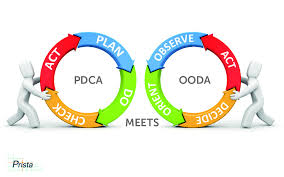In today’s rapidly evolving business landscape, the ability to make swift and effective decisions is paramount for success. Amidst the chaos and uncertainty, methodologies like OODA (Observe, Orient, Decide, Act) have emerged as powerful tools to navigate complexity and gain a competitive edge. In this article, we’ll delve into the essence of OODA methodology, compare it with the PDCA (Plan, Do, Check, Act) approach, and explore why OODA stands out as the preferred choice for agile decision-making.

Understanding OODA:
Developed by military strategist Colonel John Boyd, the OODA loop is a framework designed to optimize decision-making processes in dynamic environments. It emphasizes the importance of continuous observation, rapid orientation, decisive action, and iterative learning. Unlike traditional linear models, OODA operates as a fluid cycle, enabling individuals and organizations to adapt swiftly to changing circumstances.

Comparing OODA with PDCA:
While both methodologies aim to enhance decision-making, they differ significantly in their approach and applicability:
| OODA | PDCA | |
| 1.Iterative Learning and Feedback | One of the key strengths of OODA is its emphasis on iterative learning and feedback loops. By continuously reassessing the impact of actions and refining strategies, practitioners can rapidly improve their decision-making capabilities over time. | While PDCA advocates for periodic checks and adjustments, its sequential nature may result in longer feedback cycles, delaying the identification of inefficiencies or opportunities for improvement. |
| 2.Flexibility and Adaptability | OODA thrives on flexibility and adaptability, allowing for quick adjustments in response to unfolding situations. Its iterative nature enables practitioners to remain proactive and responsive in turbulent environments. | PDCA, on the other hand, follows a more sequential process, which may limit its effectiveness in highly dynamic settings. It relies heavily on predefined plans, potentially hindering the ability to pivot swiftly when conditions change. |
| 3.Emphasis on Observation and Orientation | OODA places a strong emphasis on observation and orientation, encouraging individuals to gather real-time data, analyze it effectively, and swiftly adjust their mental models. This proactive stance enhances situational awareness and facilitates informed decision-making. | While PDCA also incorporates elements of observation and analysis, its linear structure may lead to a more rigid mindset, making it challenging to course-correct rapidly in response to emerging insights. |
Why OODA Prevails:
In today’s volatile and uncertain world, the OODA methodology offers a compelling framework for adaptive decision-making. Its emphasis on agility, flexibility, and rapid feedback aligns perfectly with the demands of modern business environments. By embracing the OODA loop, organizations can enhance their resilience, outmaneuver competitors, and capitalize on emerging opportunities.
Conclusion:
In the battle for competitive advantage, the ability to make timely and effective decisions can make all the difference. While methodologies like PDCA have their merits, the OODA framework shines as a beacon of adaptability and agility. By embracing the OODA loop, individuals and organizations can navigate uncertainty with confidence, staying one step ahead in an ever-changing world. Embrace OODA, and empower your journey towards success.

